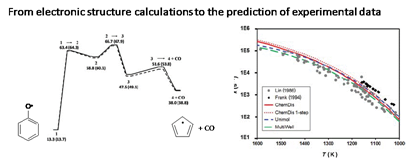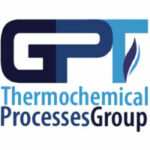SOBRE MÍ
Research Interests
Kinetic analysis of complex gas phase reactions related to environmental chemistry, pyrolysis and combustion. I have a background as experimentalist (laser photolysis / LIF detection; low pressure flame studies using MBMS techniques or flow reactors combined with GC analysis) but work recently mainly on ab initio calculated thermochemistry. The objective of my current research is to develop software that automatically generated concise but complete reaction networks for predetermined conditions using a rate-based criterion for reaction selection.

PUBLICATIONS
2022
Gil-Lalaguna, Noemí; Navarro-Gil, África; Carstensen, Hans-Heinrich; Ruiz, Joaquín; Fonts, Isabel; Ceamanos, Jesús; Murillo, María Benita; Gea, Gloria
CO2 adsorption on pyrolysis char from protein-containing livestock waste: How do proteins affect? Artículo de revista
En: Science of The Total Environment, vol. 846, pp. 157395, 2022, ISSN: 0048-9697.
@article{Gil-Lalaguna2022,
title = {CO2 adsorption on pyrolysis char from protein-containing livestock waste: How do proteins affect?},
author = {Noemí Gil-Lalaguna and África Navarro-Gil and Hans-Heinrich Carstensen and Joaquín Ruiz and Isabel Fonts and Jesús Ceamanos and María Benita Murillo and Gloria Gea},
doi = {10.1016/J.SCITOTENV.2022.157395},
issn = {0048-9697},
year = {2022},
date = {2022-11-01},
urldate = {2022-11-01},
journal = {Science of The Total Environment},
volume = {846},
pages = {157395},
publisher = {Elsevier},
abstract = {Biogas generation through anaerobic digestion provides an interesting opportunity to valorize some types of animal waste materials whose management is increasingly complicated by legal and environmental restrictions. To successfully expand anaerobic digestion in livestock areas, operational issues such as digestate management must be addressed in an economical and environmentally sustainable way. Biogas upgrading is another necessary stage before intending it to add-value applications. The high concentration of CO2 in biogas results in a reduced caloric value, so the removal of CO2 would be beneficial for most end-users. The current work evaluates the CO2 uptake properties (thermogravimetry study) of low-cost adsorbent materials produced from the animal wastes generated in the livestock area itself, specifically via pyrolysis of poorly biodegradable materials, such as meat and bone meal, and the digestate from manure anaerobic digestion. Therefore, the new element in this study with respect to other studies found in the literature related to biochar-based CO2 adsorption performance is the presence of high content of pyrolyzed proteins in the adsorbent material. In this work, pyrolyzed chars from both meat and bone meal and co-digested manure have been proven to adsorb CO2 reversibly, and also the chars produced from their representative pure proteins (collagen and soybean protein), which were evaluated as model compounds for a better understanding of the individual performance of proteins. The ultra-microporosity developed in the protein chars during pyrolysis seems to be the main explanation for such CO2 uptake capacities, while neither the BET surface area nor N-functionalities on the char surface can properly explain the observed results. Although the CO2 adsorption capacities of these pristine chars (6–41.0 mg CO2/g char) are far away from data of commercially activated carbons ($sim$80 mg CO2/g char), this application opens a new via to integrate and valorize these wastes in the circular economy of the primary sector.},
keywords = {},
pubstate = {published},
tppubtype = {article}
}
Bourgalais, Jérémy; Carstensen, Hans-Heinrich; Herbinet, Olivier; Garcia, Gustavo A.; Arnoux, Philippe; Tran, Luc-Sy; Vanhove, Guillaume; Nahon, Laurent; Hochlaf, Majdi; Battin-Leclerc, Frédérique
Product Identification in the Low-Temperature Oxidation of Cyclohexane Using a Jet-Stirred Reactor in Combination with SVUV-PEPICO Analysis and Theoretical Quantum Calculations Artículo de revista
En: The Journal of Physical Chemistry A, vol. 126, no 34, pp. 5784–5799, 2022, ISSN: 1089-5639.
@article{Bourgalais2022,
title = {Product Identification in the Low-Temperature Oxidation of Cyclohexane Using a Jet-Stirred Reactor in Combination with SVUV-PEPICO Analysis and Theoretical Quantum Calculations},
author = {Jérémy Bourgalais and Hans-Heinrich Carstensen and Olivier Herbinet and Gustavo A. Garcia and Philippe Arnoux and Luc-Sy Tran and Guillaume Vanhove and Laurent Nahon and Majdi Hochlaf and Frédérique Battin-Leclerc},
url = {https://pubs.acs.org/doi/full/10.1021/acs.jpca.2c04490},
doi = {10.1021/ACS.JPCA.2C04490/ASSET/IMAGES/MEDIUM/JP2C04490_0020.GIF},
issn = {1089-5639},
year = {2022},
date = {2022-09-01},
journal = {The Journal of Physical Chemistry A},
volume = {126},
number = {34},
pages = {5784--5799},
publisher = {American Chemical Society (ACS)},
abstract = {Cyclohexane oxidation chemistry was investigated using a near-atmospheric pressure jet-stirred reactor at T = 570 K and equivalence ratio ϕ = 0.8. Numerous intermediates including hydroperoxides an...},
keywords = {},
pubstate = {published},
tppubtype = {article}
}
Tran, Luc Sy; Herbinet, Olivier; Carstensen, Hans-Heinrich; Battin-Leclerc, Frédérique
Chemical kinetics of cyclic ethers in combustion Artículo de revista
En: Progress in Energy and Combustion Science, vol. 92, pp. 101019, 2022, ISSN: 0360-1285.
@article{Tran2022,
title = {Chemical kinetics of cyclic ethers in combustion},
author = {Luc Sy Tran and Olivier Herbinet and Hans-Heinrich Carstensen and Frédérique Battin-Leclerc},
doi = {10.1016/J.PECS.2022.101019},
issn = {0360-1285},
year = {2022},
date = {2022-09-01},
urldate = {2022-09-01},
journal = {Progress in Energy and Combustion Science},
volume = {92},
pages = {101019},
publisher = {Pergamon},
abstract = {Cyclic Ethers (CEs) belong to a class of compounds of importance to understand the chemistry of both the engine auto-ignition of hydrocarbon fuels and the combustion of oxygenated biofuels. This article, divided in six parts, aims at systematically analyzing how up-to-date experimental and theoretical methods were applied to unveil the gas-phase oxidation chemistry of these compounds. The first part gives a brief overview on the significance of CEs as intermediates formed during alkane low-temperature oxidation summarizing its generally accepted chemical mechanism. This part also addresses the role of CEs as potential biofuels derived from lignocellulosic biomass and discusses the production methods of these molecules and their combustion performances in engine. The second part presents the different theoretical methods dedicated to calculate the electronic structure, thermochemical and kinetic data of CEs. The third part introduces the experimental methods used in studies related to CEs with a special focus on mass spectrometry and gas chromatography. The fourth part reviews the experimental and modeling studies related to CE formation during the low-temperature oxidation of linear, branched, cyclic alkanes, alkylbenzenes, olefins, and oxygenated fuels. The fifth part analyses the published work concerning the CE degradation chemistry and highlights the dominant involved reactions. To finish, the sixth part concludes and proposes future research directions.},
keywords = {},
pubstate = {published},
tppubtype = {article}
}
2021
Bourgalais, Jérémy; Herbinet, Olivier; Carstensen, Hans-Heinrich; Debleza, Janney; Garcia, Gustavo A.; Arnoux, Philippe; Tran, Luc Sy; Vanhove, Guillaume; Liu, Binzhi; Wang, Zhandong; Hochlaf, Majdi; Nahon, Laurent; Battin-Leclerc, Frédérique
Jet-Stirred Reactor Study of Low-Temperature Neopentane Oxidation: A Combined Theoretical, Chromatographic, Mass Spectrometric, and PEPICO Analysis Artículo de revista
En: Energy and Fuels, vol. 35, no 23, pp. 19689–19704, 2021, ISSN: 15205029.
@article{Bourgalais2021,
title = {Jet-Stirred Reactor Study of Low-Temperature Neopentane Oxidation: A Combined Theoretical, Chromatographic, Mass Spectrometric, and PEPICO Analysis},
author = {Jérémy Bourgalais and Olivier Herbinet and Hans-Heinrich Carstensen and Janney Debleza and Gustavo A. Garcia and Philippe Arnoux and Luc Sy Tran and Guillaume Vanhove and Binzhi Liu and Zhandong Wang and Majdi Hochlaf and Laurent Nahon and Frédérique Battin-Leclerc},
url = {https://pubs.acs.org/doi/full/10.1021/acs.energyfuels.1c02080},
doi = {10.1021/ACS.ENERGYFUELS.1C02080/SUPPL_FILE/EF1C02080_SI_002.XLSX},
issn = {15205029},
year = {2021},
date = {2021-12-01},
urldate = {2021-12-01},
journal = {Energy and Fuels},
volume = {35},
number = {23},
pages = {19689--19704},
publisher = {American Chemical Society},
abstract = {The oxidation of neopentane was studied in jet-stirred reactors at atmospheric pressure over a temperature range 500-850 K and $phi$ = 0.5. The products were analyzed with chromatographic, mass spectrometric, and photoelectron spectroscopic setups complemented with theoretical calculations. This combination provides a comparison of photo-ionization mass spectrometry and gas chromatography for the quantification of mole fractions and highlights the relevant differences between them, while mass-tagged photoelectron spectroscopy sheds light onto the isomeric distribution. The new data and corresponding analyses are expected to provide valuable guidance for an extension of the kinetic model and the choice of experimental methods. The main first and second O2-addition products were observed in agreement with the literature (e.g., 3,3-dimethyloxetane, acetone, isobutene, and ?-ketohydroperoxide). The simulated mole fractions of the products using a literature kinetic model were compared to the experimental results. Even though the kinetic model has been validated previously, significant discrepancies between the measured and simulated mole fractions of 2-methylpropanal and methacrolein, two fuel-specific low-temperature oxidation products, were found. Furthermore, some experimentally observed species related to ?-ketohydroperoxide decomposition were not predicted indicating that the model is incomplete. The detection of 2-methylpropanal and formic acid highlighted the importance of the Korcek-type pathway.},
keywords = {},
pubstate = {published},
tppubtype = {article}
}
Pelucchi, Matteo; Arunthanayothin, Suphaporn; Song, Yu; Herbinet, Olivier; Stagni, Alessandro; Carstensen, Hans-Heinrich; Faravelli, Tiziano; Battin-Leclerc, Frédérique
Pyrolysis and combustion chemistry of pyrrole, a reference component for bio-oil surrogates: Jet-stirred reactor experiments and kinetic modeling Artículo de revista
En: Energy and Fuels, vol. 35, no 9, pp. 7265–7284, 2021, ISSN: 15205029.
@article{Pelucchi2021,
title = {Pyrolysis and combustion chemistry of pyrrole, a reference component for bio-oil surrogates: Jet-stirred reactor experiments and kinetic modeling},
author = {Matteo Pelucchi and Suphaporn Arunthanayothin and Yu Song and Olivier Herbinet and Alessandro Stagni and Hans-Heinrich Carstensen and Tiziano Faravelli and Frédérique Battin-Leclerc},
url = {https://dx.doi.org/10.1021/acs.energyfuels.0c03874},
doi = {10.1021/acs.energyfuels.0c03874},
issn = {15205029},
year = {2021},
date = {2021-05-01},
journal = {Energy and Fuels},
volume = {35},
number = {9},
pages = {7265--7284},
publisher = {American Chemical Society},
abstract = {Fast-pyrolysis bio-oils (FPBOs) obtained from lignocellulosic biomass are gaining attention as sustainable fuels for various applications, including the transport sector and power production. A significant fraction of bio-oils is constituted by nitrogen-containing compounds (N fuels) that should be considered when developing surrogate models for FPBOs. Moreover, the content of N fuels in FPBOs is expected to strongly contribute to the production of nitrogen oxides (NOx) directly from fuel-bound nitrogen (fuel NOx), in addition to the thermal NOx formation pathways typical of high-temperature combustion conditions. This work investigates the pyrolysis and combustion chemistry of pyrrole (C4H5N), a candidate reference fuel component for FPBO surrogate models. Speciation measurements in an atmospheric pressure jet-stirred reactor have been performed for both pyrolysis and oxidation conditions. Pyrolysis experiments have been performed for 1% pyrrole/helium mixtures over the temperature range T = 925.1200 K. Oxidation experiments were carried out for 1% pyrrole/oxygen/helium mixtures at three equivalence ratios ($phi$ = 0.5, 1.0, and 2.0) over the temperature range T = 700. 1200 K. These new data significantly extend the number of experimental targets for kinetic model validation available at present for pyrrole combustion. After a thorough revision of previous theoretical and kinetic modeling studies, a preliminary kinetic model is developed and validated by means of comparison to new experimental data and those previously reported in the literature. The rate of production and sensitivity analyses highlight important pathways deserving further investigations for a better understanding of pyrrole and, more in general, N fuel combustion chemistry. A critical discussion on experimental challenges to be faced when dealing with pyrrole is also reported, encouraging further experimental investigation with advanced diagnostics.},
keywords = {},
pubstate = {published},
tppubtype = {article}
}


